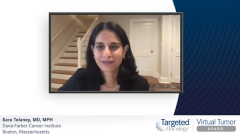
Case 1: De-Escalation of Adjuvant Anti-HER2 Therapy for Breast Cancer
Episodes in this series

Ruta Rao, MD: Let’s move on to a different topic in the adjuvant setting. Let’s talk about deescalation of therapy. We’ve talked in the neoadjuvant setting about escalation of therapy, especially for patients who do not achieve a pathologic complete response. Let’s touch on the deescalation of adjuvant anti-HER2 [human epidermal growth factor receptor 2] therapy, which you had started to allude to for the patients with smaller node-negative tumors. Dr Tolaney, do you want to summarize the data we know so far?
Sara Tolaney, MD, MPH: For small node-negative tumors, the data that we have for de-escalation predominantly comes from the APT [adjuvant paclitaxel-trastuzumab] trial and the ATEMPT trial. APT looked at a year of paclitaxel and trastuzumab in patients who have node-negative, HER2-positive tumors that were less than or equal to 3 cm, and it demonstrated with 7 years of follow-up that the recurrence-free interval was 97.5%. Rare distant recurrences were seen in this trial, so TH [taxane, trastuzumab] has become an option for many of our stage I patients.
Our group [at Dana-Farber Cancer Institute] in particular was interested in seeing if we could get away with something, and we even thought it had potential to be less toxic than TH [taxane, trastuzumab], utilizing T-DM1 [trastuzumab emtansine]. We knew in the metastatic setting that T-DM1 [trastuzumab emtansine] seemed to be at least equally efficacious compared with TH [taxane, trastuzumab] did in the ATEMPT trial, which looked at a year of T-DM1 [trastuzumab emtansine] and compared it with TH [taxane, trastuzumab]. But it is important to note that the comparison was only for toxicity and that the study was designed to evaluate efficacy for a year of T-DM1 [trastuzumab emtansine] and then to compare the 2 arms for toxicity. It found few recurrences in the T-DM1 [trastuzumab emtansine] arm. Of the 375 patients who got T-DM1 [trastuzumab emtansine], there were only 2 distant recurrences, so the 3-year disease-free survival was almost 98%: an excellent efficacy with T-DM1 [trastuzumab emtansine].
When we compared clinically relevant toxicities, which was an end point we defined, there was no difference between the 2 arms. The percentages of clinically relevant toxicities was identical between the arms, but there were different toxicity profiles. We know T-DM1 [trastuzumab emtansine] was associated with more thrombocytopenia and more LFT [liver function test] issues, whereas TH [taxane, trastuzumab] was associated with more neurotoxicity, alopecia, and infusion reactions. They have different toxicity profiles, but what we learned was that, when we looked at patient-reported outcomes like quality of life, quality of life was actually better in the T-DM1 [trastuzumab emtansine] arm. We also saw that there was less impairment of work productivity, and we saw there was less amenorrhea with T-DM1 [trastuzumab emtansine] for our premenopausal patients on the trial.
Given the totality of the data, I felt comfortable thinking about T-DM1 [trastuzumab emtansine]. One challenge was that there was a high rate of treatment discontinuation in that arm: almost 20%. It has made us wonder about how, if there’s such good efficacy yet people need to discontinue early for toxicity, we could get away with an even shorter duration of T-DM1 [trastuzumab emtansine]. We have a trial planned to look at 6 cycles of T-DM1 [trastuzumab emtansine] in the adjuvant setting for stage I patients, and we’ll learn more. For now, it’s a nice space to de-escalate our lower-risk stage I patients.
Ruta Rao, MD: Dr Jhaveri, can you comment on whether listening to the T-DM1 [trastuzumab emtansine] data changes your practice for these smaller node-negative patients?
Komal Jhaveri, MD, FACP: It was definitely an option that came up more in a timely way given the COVID-19 [coronavirus disease 2019] era that we’re dealing with. It became more important to think about that data for our patients because we’re bringing these patients in every 3 weeks vs weekly infusions, perhaps with immunosuppression. As Dr Tolaney was pointing out, the discontinuation rates were high, and it didn’t seem superior, so it did not necessarily change my practice. I offer TH [taxane, trastuzumab], but it was a reasonable option, and it certainly was a reasonable consideration in March and April when we were dealing with COVID-19 in New York, and the pandemic was a significant issue at that time. It is something we could have thought about for our small-tumor patients who needed to initiate therapy.
Ruta Rao, MD: That’s an excellent point, thinking about the amount of time patients have to come in for the treatment and how that would serve their purposes better given the current situation.
Komal Jhaveri, MD, FACP: The 6 cycles of T-DM1 [trastuzumab emtansine] would be an interesting attempt to look at whether we can get away with a shorter duration with T-DM1 [trastuzumab emtansine], avoid the discontinuations, and be able to maintain the efficacy for these small-tumor patients. That would be an important attempt.
Transcript edited for clarity.














































